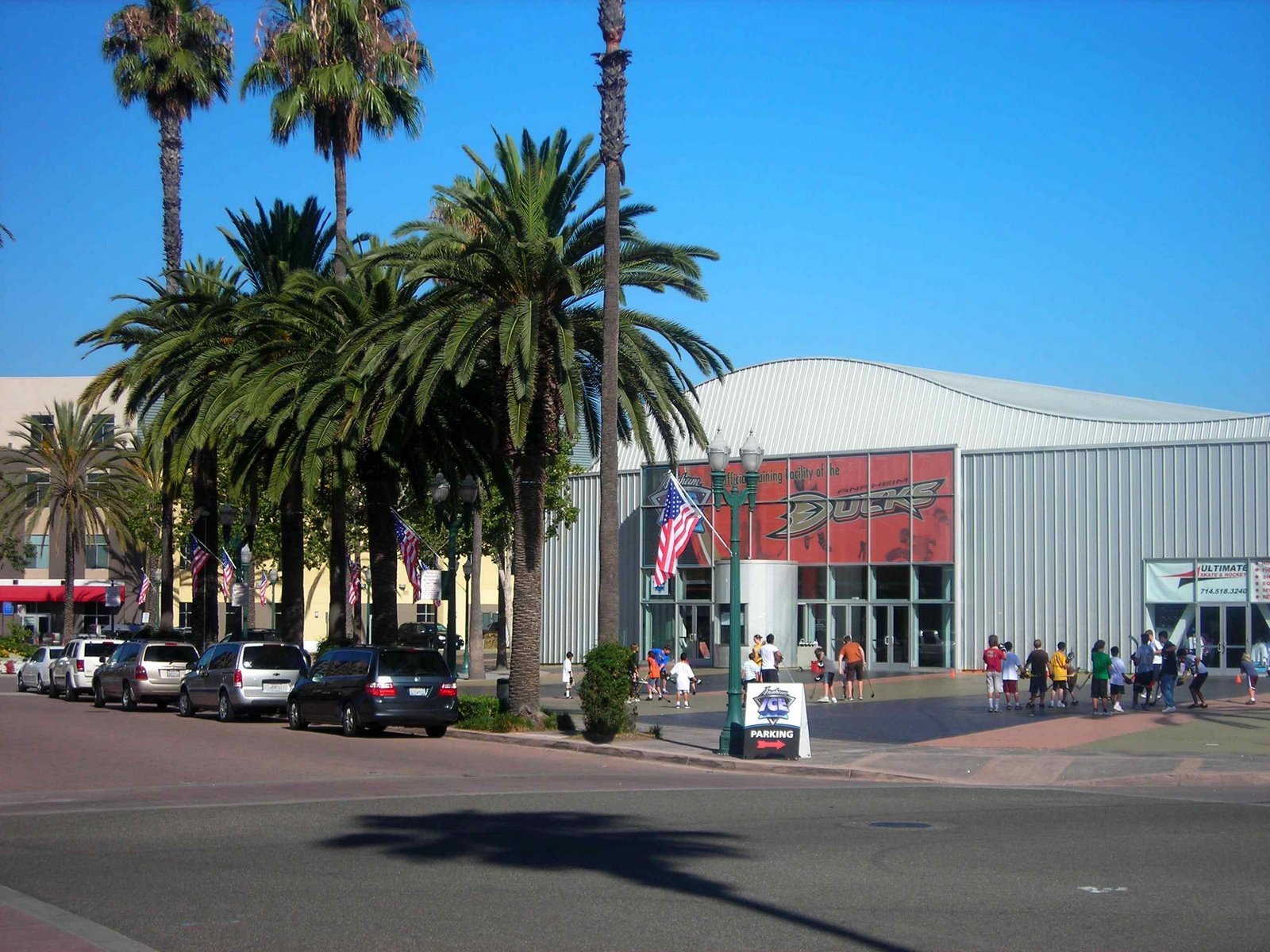 It's not directly related to Atlantic Yards, but a look at Frank Gehry’s ice rink in Anaheim, CA, originally dubbed Disney Ice and now called Anaheim Ice, offers a cautionary tale about promises made for ambitious architecture.
It's not directly related to Atlantic Yards, but a look at Frank Gehry’s ice rink in Anaheim, CA, originally dubbed Disney Ice and now called Anaheim Ice, offers a cautionary tale about promises made for ambitious architecture.Notably, the structure, when it opened in 1995, did not contain some of the Gehryesque elements announced, it did not prompt the redevelopment of nearby parcels, and, counter to the expectations of its builders, it did not spawn a national effort to teach inner-city youths ice hockey.
(It was built in part as a practice rink for the Mighty Ducks of Anaheim; I'll bet that Gehry does not design the practice facility for the Nets that Forest City Ratner now promises in Brooklyn.)
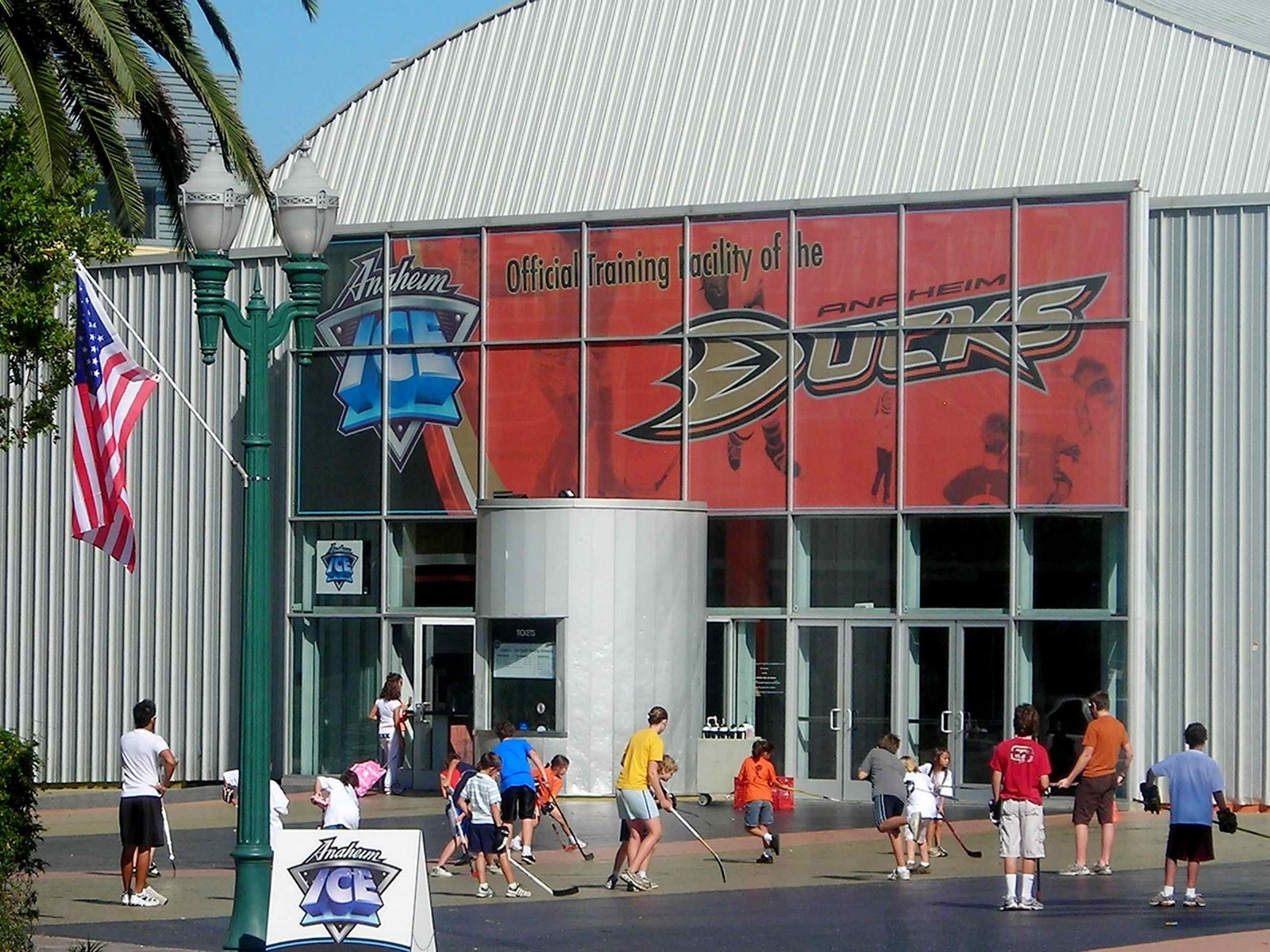 Such sobering reality is accessible to anyone who takes a serious scan of local news coverage, but if you read the New York Times, the only extant look at the rink--other than two throwaway mentions--was a review written 9/18/94 by architecture critic Herbert Muschamp, a Gehry champion, some 13 months before the building opened.
Such sobering reality is accessible to anyone who takes a serious scan of local news coverage, but if you read the New York Times, the only extant look at the rink--other than two throwaway mentions--was a review written 9/18/94 by architecture critic Herbert Muschamp, a Gehry champion, some 13 months before the building opened.
The building serves as the practice rink for the Anaheim Ducks (originally Mighty Ducks of Anaheim) team in the National Hockey League (NHL). It includes one standard NHL-size rink, and one Olympic-size rink, is striking but hardly urban from the outside, an island of corrugated steel, but handsome on the inside, the rinks defined by curvaceous wood beams. It seems to get steady use from youth skating, beyond serving as a practice facility.
Writing too soon
 Notably, the Times review was written when the building was about to go into construction, not after it opened and was used. Thus Muschamp could gush about the building as a piece of sculpture, not a messy, living thing with blank walls backing into a major avenue, though years later, as the photo shows, there's a new development (at right in picture) bordering the rink.
Notably, the Times review was written when the building was about to go into construction, not after it opened and was used. Thus Muschamp could gush about the building as a piece of sculpture, not a messy, living thing with blank walls backing into a major avenue, though years later, as the photo shows, there's a new development (at right in picture) bordering the rink.
Similarly, he could proclaim, improbably at the time and incredibly in retrospect--that the Atlantic Yards arena, as designed, would be an “urban garden.” (Now even the promised green roof is gone.)
Muschamp’s essay, headlined Disney Takes the Ice to the Players, explained that the rink would be a practice rink for the team:

Initially conceived as a home base for Disney's N.H.L. team, the Mighty Ducks, the arena will also provide a community center for what Anaheim officials hope will become a vibrant downtown district. With walls and roof sheathed in corrugated aluminum, finished to the semi-gloss of freshly resurfaced ice, the building is plainly intended to stand out as a city landmark. And its shape, which will be visible from all four sides, also evokes imagery of winter sports. The structure rises from the ground in a steep convex slope, then swells into two silvery crests with a gentle dip in the middle. The effect is of two big Quonset huts that have partly melted together then magically congealed: an inner-city ski run for a contemporary Cinderella.
The name of the arena -- for now, the Disney people are calling it Goals, though that may change -- will be spelled out on the front and back of the building in curving metal letters three stories tall. If you look at the arena sideways, you may be able to make out that the letters form a stylized pair of mouse ears. On the other hand, you don't have to. An entrance canopy -- unmistakably a stylized duck bill -- projects over a plaza painted in radiating stripes of purple, green and yellow, the Ducks' team colors. (Even Ro bert Venturi has never designed so literal a duck.) A big silver puck will hold the street edge of the plaza; you'll be able to buy your own hockey stick at the sporting-goods store housed inside it. Rows of palm trees will set this alpine apparition within a tropical frame.
bert Venturi has never designed so literal a duck.) A big silver puck will hold the street edge of the plaza; you'll be able to buy your own hockey stick at the sporting-goods store housed inside it. Rows of palm trees will set this alpine apparition within a tropical frame.
Design changes
As photos from my recent visit show, no such three-story metal letters exist, nor do a stylized duck bill or silver puck. (Similarly, some of the flourishes announced for the Atlantic Yards arena, such as a rooftop park open to the public and even a green roof, have vanished.) What happened?
A 5/4/95 Los Angeles Times article, headlined "Disney Ice Rink Gets New, Cost-Saving Look," explained that the Anaheim City Council had just approved revised plans that eliminated a costly sign envisioned by Gehry. The news came in the wake of criticism of Gehry in the area for “cost overruns like the ones that have plagued the Walt Disney Concert Hall in Los Angeles.”
The newspaper reported:
The original sign by Gehry was an architectural feature that blended into the front of the building. Its graphic elements and canopy were found to be "economically infeasible," according to a city staff report.
While Disney officials would not disclose the estimated cost of the building, a council member told the newspaper the building would cost $10 million to $12 million--nearly 100 times less than the Atlantic Yards arena, now estimated at $850 million.
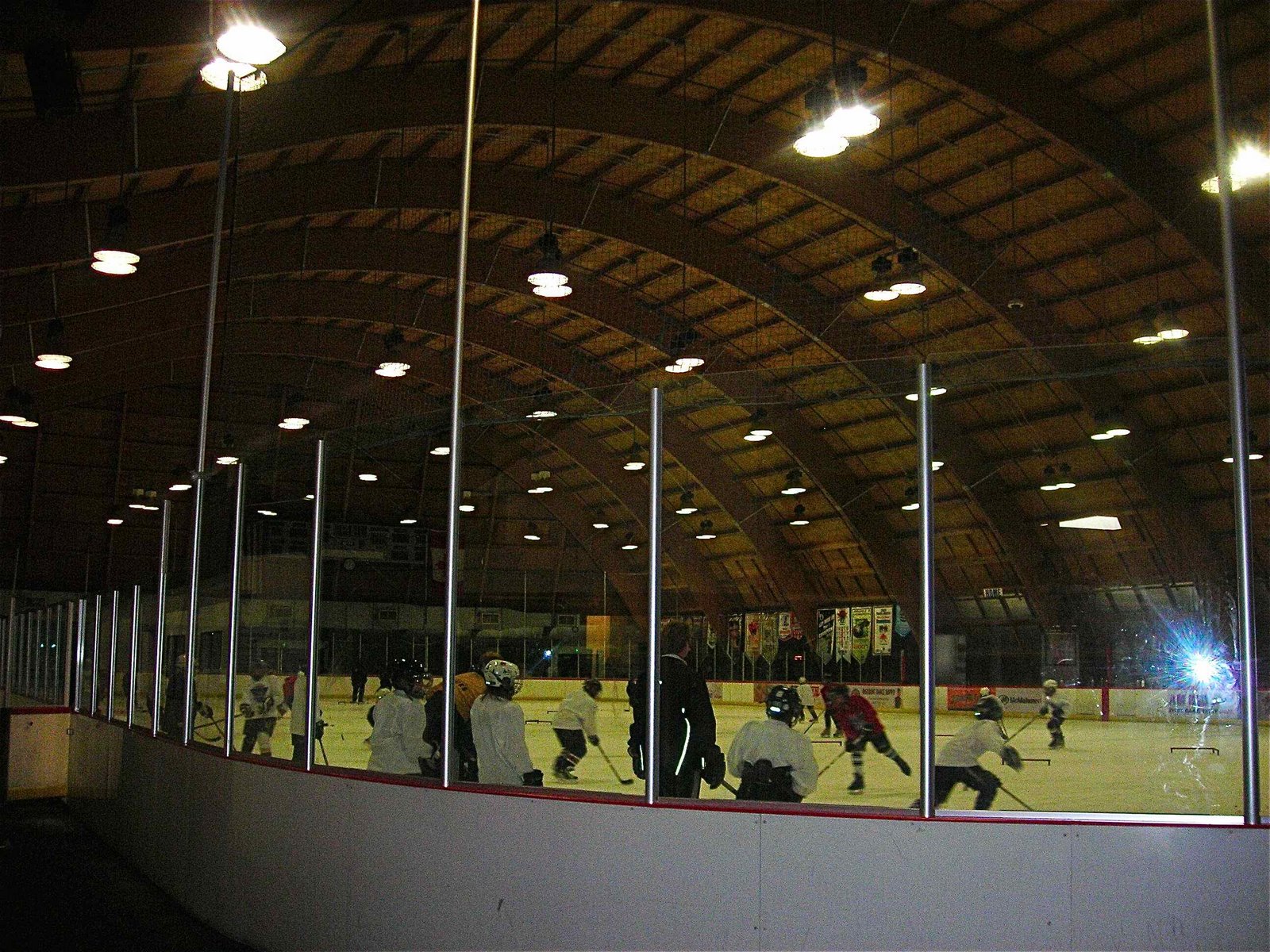 An 11/12/95 Los Angeles Times review, headlined "Gehry Goes with the Floe," said it cost $8.5 million.
An 11/12/95 Los Angeles Times review, headlined "Gehry Goes with the Floe," said it cost $8.5 million.
That review, praised Disney Ice as “a rare case of a hockey rink transformed into attractive architecture,” suggesting that the exterior was welcoming and the interior “warm and sheltering.” (I’d agree with the latter but not the former.)
A reader from Anaheim was a bit more skeptical, suggesting in a 12/3/95 letter:
I have seen better looking Quonset huts in the most desolate parts of the world that were put up in a day.
Gehry told the newspaper that one of Muschamp’s faves had been nixed:
"At one point I actually had a canopy shaped like a duck's bill over the entry, but the client felt it was a touch too fanciful."
Vibrant downtown?
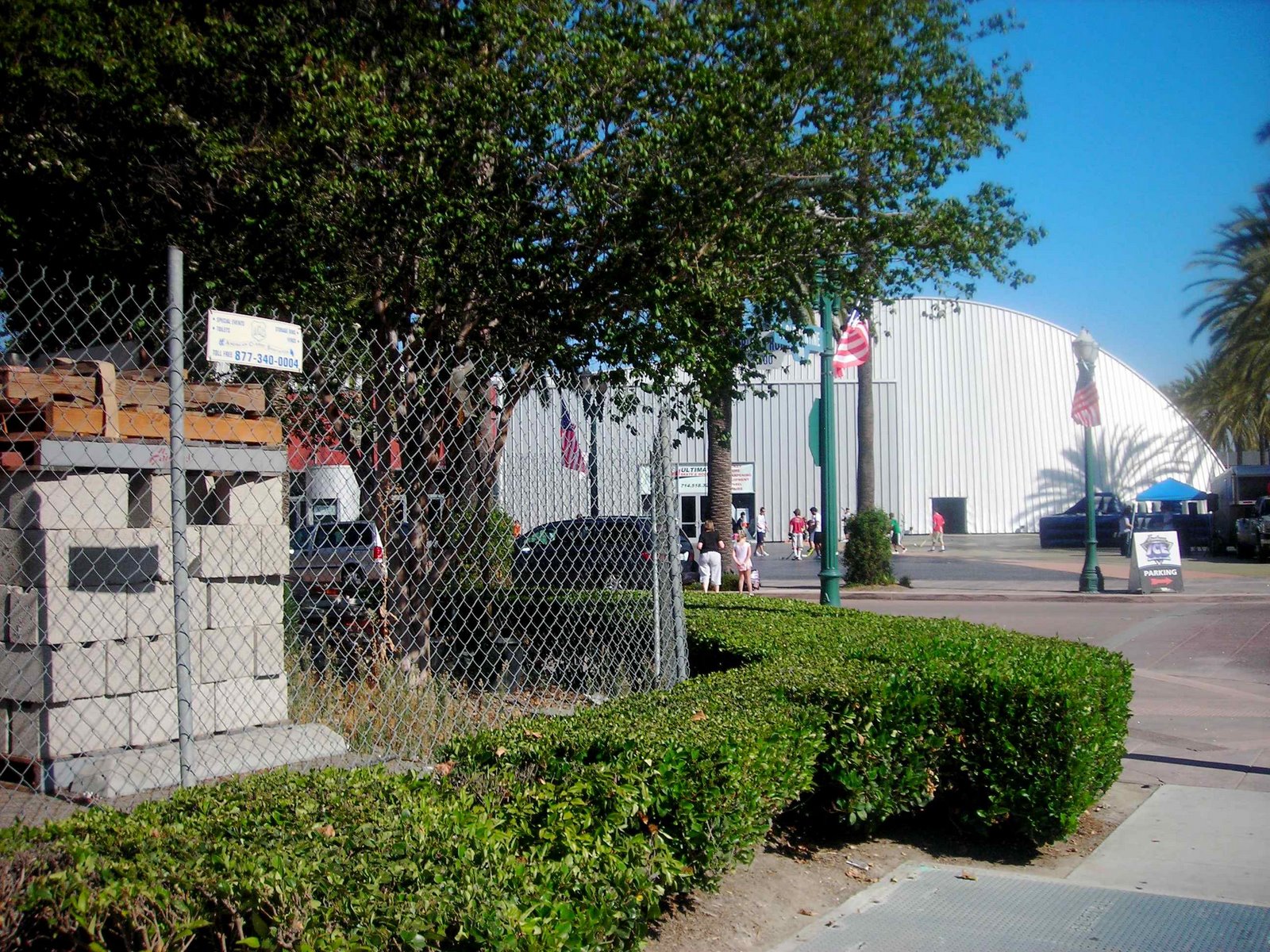 Regarding the hope for Anaheim’s revival, Muschamp was repeating the conventional wisdom, such as an 8/10/94 Los Angeles Times article, headlined "Anaheim, Disney to Built Joint-Use Ice Rink,' which stated:
Regarding the hope for Anaheim’s revival, Muschamp was repeating the conventional wisdom, such as an 8/10/94 Los Angeles Times article, headlined "Anaheim, Disney to Built Joint-Use Ice Rink,' which stated:
City officials hope that the new Community Ice Center will help revitalize downtown Anaheim.
It didn’t work. Anaheim’s downtown, more than one-and-a-half miles away from the Disneyland resort area, was long moribund. A 1/31/99 Orange County Register article about the relationship between Disney and the city of Anaheim, headlined “The Ties That Bind,” explained:
The stark facade of the Frank Gehry-designed building has been criticized by downtown merchants for its lack of landscaping. The city exempted Disney from normal landscaping rules at the request of the company's architects.
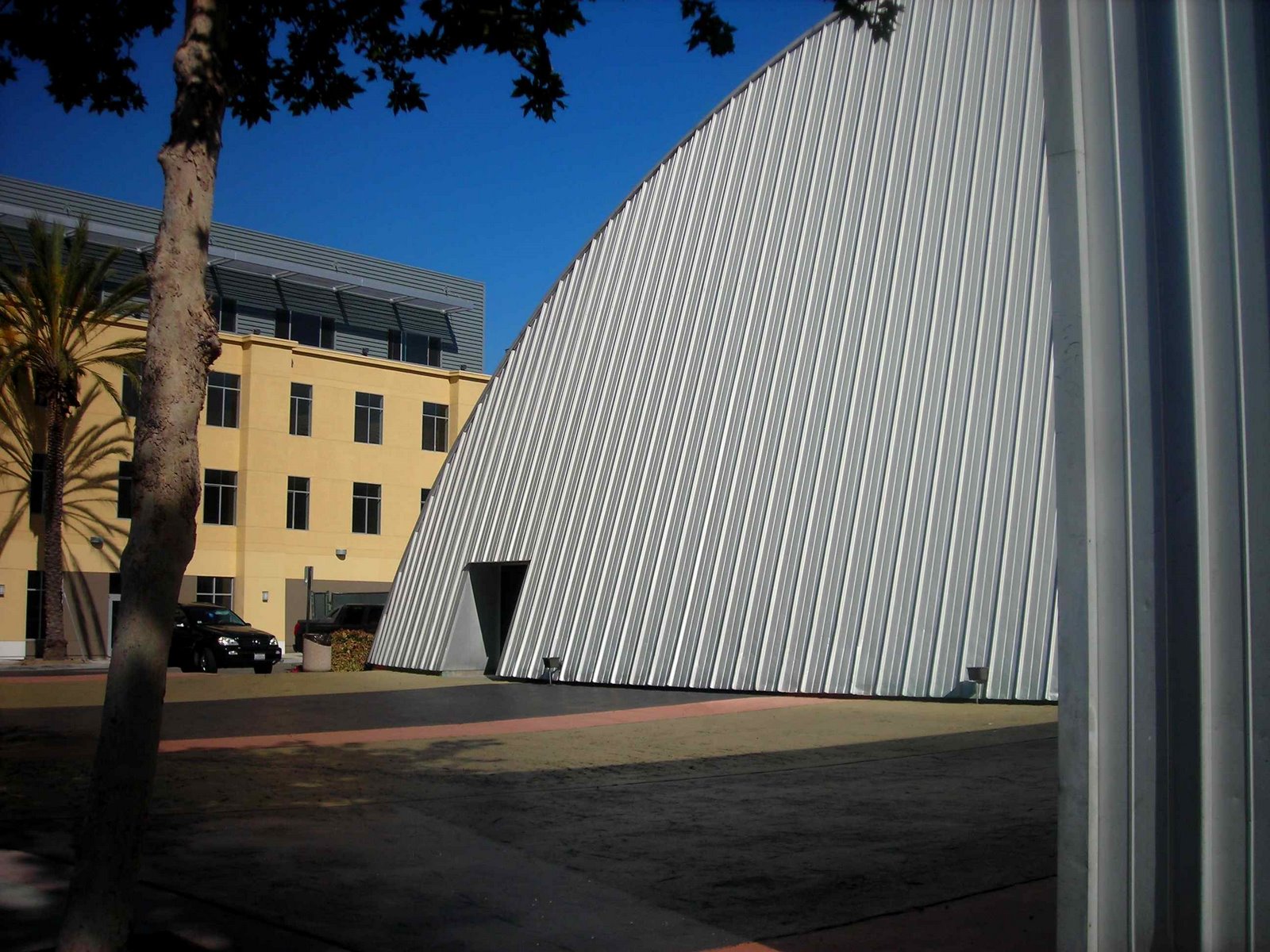 That was clearly a mistake, just as it was a mistake, in retrospect, not to require retail or other street-level activity around the rink. (Note the photo of the rink's back side near top.)
That was clearly a mistake, just as it was a mistake, in retrospect, not to require retail or other street-level activity around the rink. (Note the photo of the rink's back side near top.)
By contrast, planners for the Atlantic Yards arena, planned for an urban area already much, much busier than downtown Anaheim, say there will be retail around the building, and City Planning Commission Chair Amanda Burden even pushed for a “b-market” along Atlantic Avenue, a narrow strip of retail to accommodate smaller shops.
An arena wasn't necessary to revive the border of Prospect Heights and Downtown Brooklyn (and a site mostly in the former); an RFP process would've done fine.
 A 10/3/02 Orange County Register article headlined “Voters concerned about downtown” stated:
A 10/3/02 Orange County Register article headlined “Voters concerned about downtown” stated:
The Anaheim Boulevard Consortium for Development has also been rallying for a more commercially viable downtown for two years.
Vic Real, a member of ABCD and a West Anaheim resident, said the goal is to make the downtown area more of a destination.
''Right now you find the downtown is deserted, everyone is going home,'' he said. ''Pedestrian-friendly, that would make downtown a downtown.''
Only recently has development come to a plot next to the rink. According to an 8/13/07 Orange County Business Journal article headlined Harbor Lofts by Lee Homes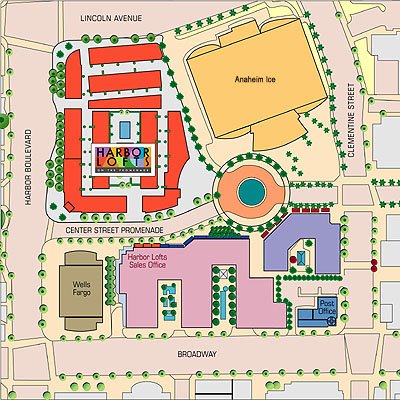 & CIM Group Attracting First Time Buyers:
& CIM Group Attracting First Time Buyers:
Harbor Lofts is Anaheim's first mixed-use building and stands as a pillar of the downtown's exciting revival.
Many of the units are still for sale, as far as I could tell, while taking a walk around the area earlier this month. It’s a sensible development, of reasonable scale, with retail on the ground floor, trying to add residents to downtown.
In fact, what it shows most of all is how the Gehry rink is anti-urban, isolated on the street, with a moat of parking. It can be fun for skateboarders, at least (see below).
A "piece of sculpture"
The rink gets unconditional kudos in the 2006 documentary Sketches of Frank Gehry, directed by Sydney Pollack, which I recently watched again.
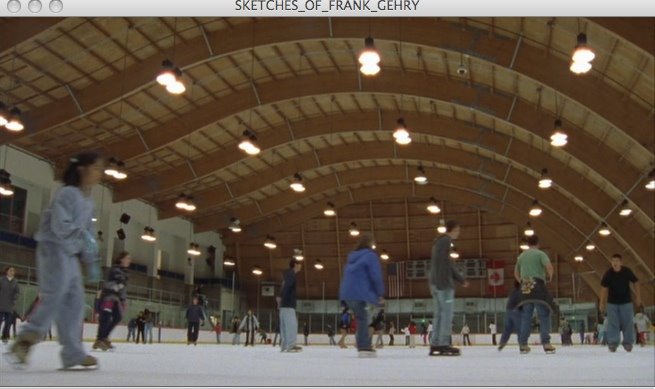
Former Disney CEO Michael Eisner explains to the camera, "We bought a hockey team. We needed a practice rink. He designed for us a hockey rink in downtown Anaheim."
Eisner's enthusiasm ramps up: "It is a piece of sculpture sitting in this town. I think that and Bilbao and a couple of other things are his best work."
As the music swells, Eisner explains, "The inside is reminiscent of those hockey rinks that Frank grew up with in Canada. All wood, all trusses, looks very traditional, it looks like you could be nostalgic for being in Toronto in 1940something."
Delivering the picture
 Finally, Eisner describes what it's like to be the client: "You give Frank the functionality, you make sure in the hockey rink you have the workout room and the locker rooms and all that stuff, and you’re on Frank that way--and then he delivers the picture."
Finally, Eisner describes what it's like to be the client: "You give Frank the functionality, you make sure in the hockey rink you have the workout room and the locker rooms and all that stuff, and you’re on Frank that way--and then he delivers the picture."
The camera pulls away to an aerial shot of the rink, notable for the parking lot in the background, now, more than a dozen years later, occupied by a development, the Harbor Lofts. In other words, "the picture" to Eisner and so many Gehry enthusiasts ignores the larger context. Sure, it's a lovely piece of sculpture. But it's in an urban environment.
 Beyond that, Eisner and the film omit the decisions to truncate Gehry's "picture" by eliminating the sign, duck bill, and puck.
Beyond that, Eisner and the film omit the decisions to truncate Gehry's "picture" by eliminating the sign, duck bill, and puck.
Social mission truncated
Muschamp wrote:
The Anaheim rink has been conceived as a pilot project for a new Disney program with a serious social mission. Directed by David Wilk, founder of a pioneering New York City program called Ice Skating in Harlem, the Goals program is being developed to serve inner-city youth. Wilk views skating as a way to develop teamwork, discipline and self-esteem.
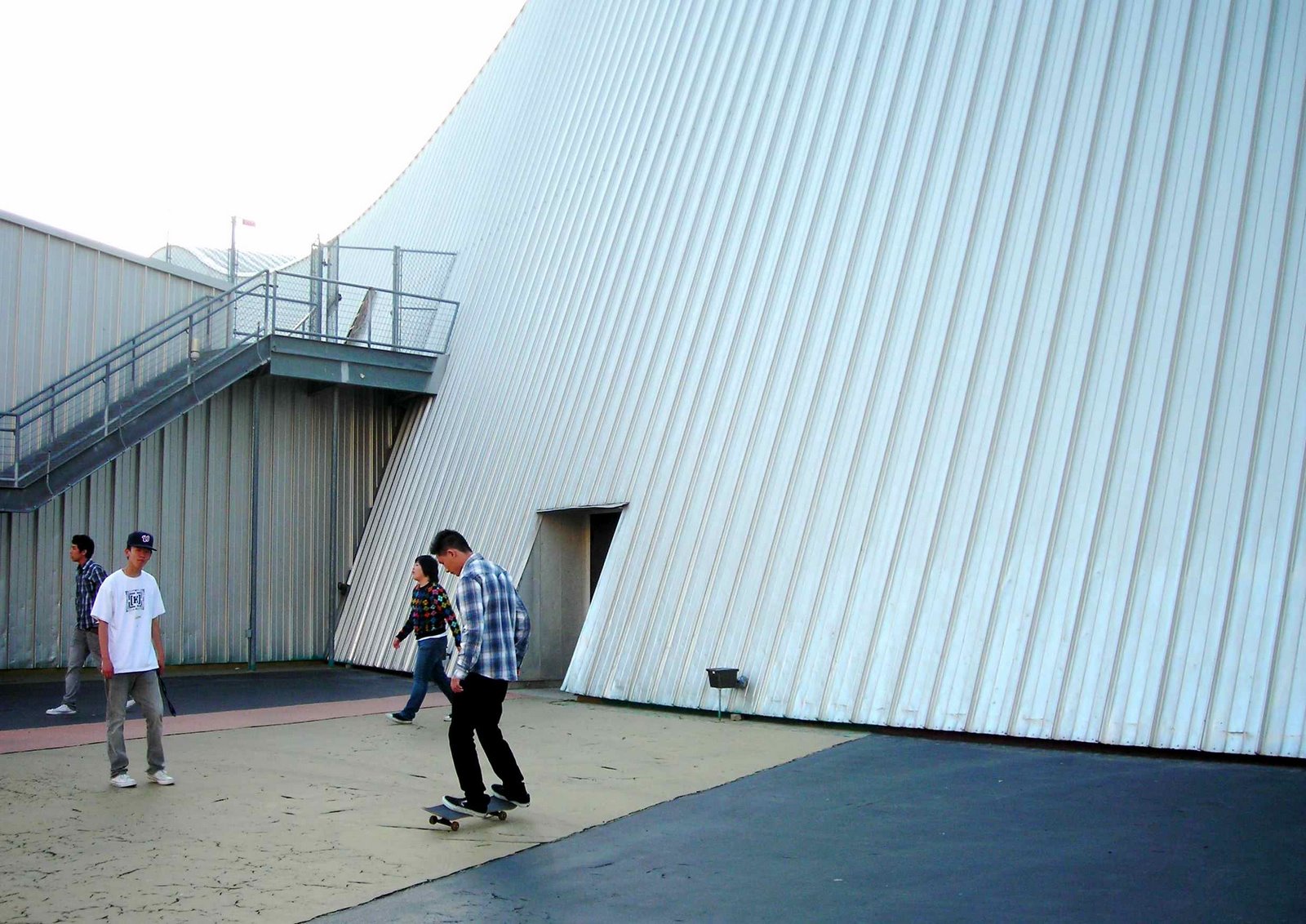 In addition to recreation, Goals will offer scholarships, internships and other educational programs. If the project succeeds in Anaheim, the plan is to replicate it in other American cities, perhaps as many as 30, in the next 10 years, according to David Malmuth of Disney's development wing.
In addition to recreation, Goals will offer scholarships, internships and other educational programs. If the project succeeds in Anaheim, the plan is to replicate it in other American cities, perhaps as many as 30, in the next 10 years, according to David Malmuth of Disney's development wing.
Well, as the photo shows, at least it's provided a haven for skateboarders.
 A 7/2/95 Orange County Register articled headlined "Disney’s Rink is All Business; It’s Mice-Free Ice," explained that the developer got a carrot to do so:
A 7/2/95 Orange County Register articled headlined "Disney’s Rink is All Business; It’s Mice-Free Ice," explained that the developer got a carrot to do so:
The city's redevelopment agency gave the 3.2-acre plot of vacant land at Lincoln Avenue and Harbor Boulevard to Disney Goals in exchange for an agreement to provide $ 4.3 million in ice-related youth and community services to the city.
And what happened to Disney GOALS? It has expanded only modestly, now operating in both the Anaheim and San Diego areas.
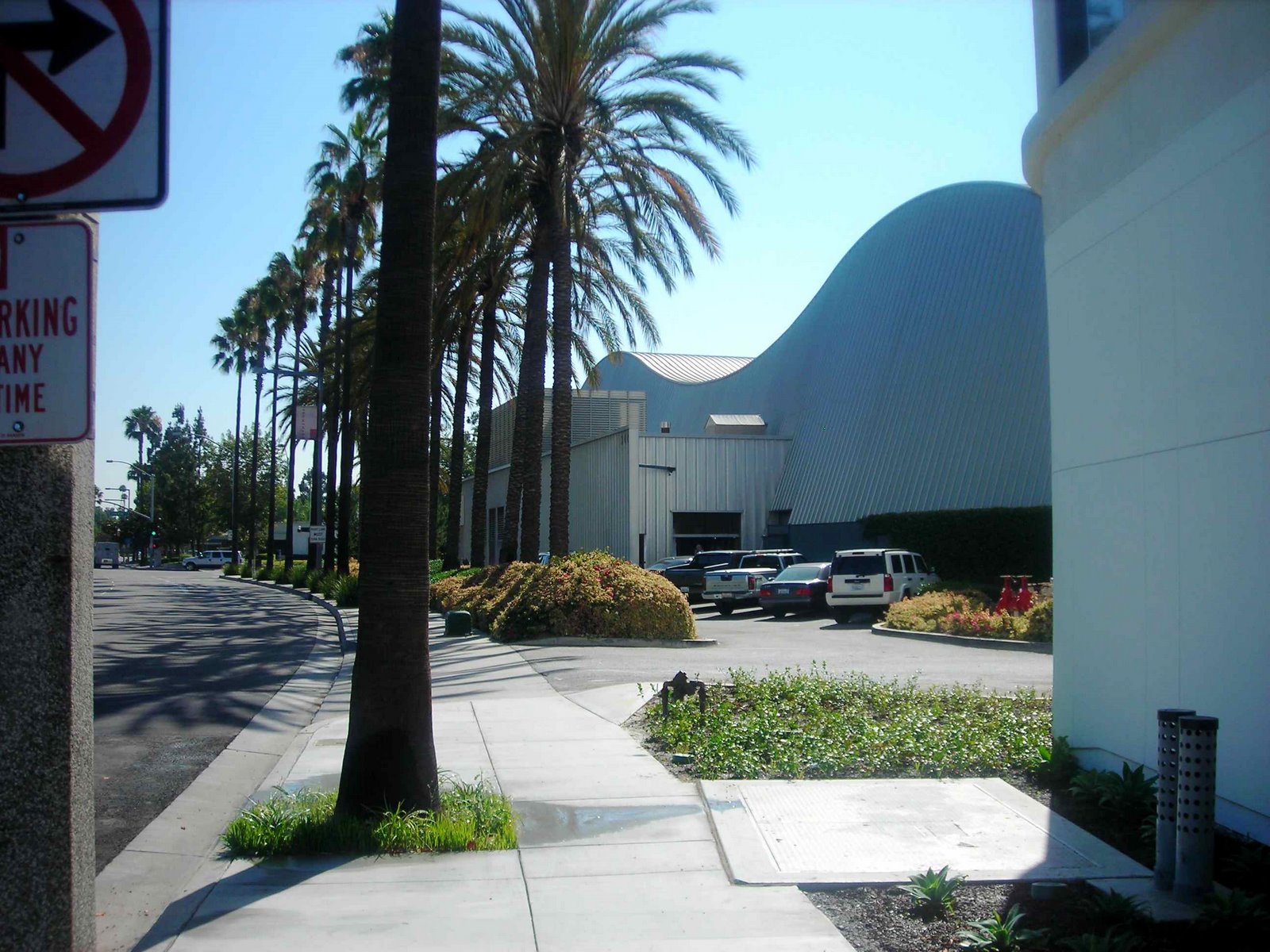 A 6/7/07 Orange County Register article, headlined "Scoring Goals," explained that, “between Orange and San Diego counties, the program serves about 2,000 youth.” While that’s nothing to criticize, it should be pointed out that it has not been replicated on the scale hoped for in Muschamp’s essay.
A 6/7/07 Orange County Register article, headlined "Scoring Goals," explained that, “between Orange and San Diego counties, the program serves about 2,000 youth.” While that’s nothing to criticize, it should be pointed out that it has not been replicated on the scale hoped for in Muschamp’s essay.
 Such sobering reality is accessible to anyone who takes a serious scan of local news coverage, but if you read the New York Times, the only extant look at the rink--other than two throwaway mentions--was a review written 9/18/94 by architecture critic Herbert Muschamp, a Gehry champion, some 13 months before the building opened.
Such sobering reality is accessible to anyone who takes a serious scan of local news coverage, but if you read the New York Times, the only extant look at the rink--other than two throwaway mentions--was a review written 9/18/94 by architecture critic Herbert Muschamp, a Gehry champion, some 13 months before the building opened.The building serves as the practice rink for the Anaheim Ducks (originally Mighty Ducks of Anaheim) team in the National Hockey League (NHL). It includes one standard NHL-size rink, and one Olympic-size rink, is striking but hardly urban from the outside, an island of corrugated steel, but handsome on the inside, the rinks defined by curvaceous wood beams. It seems to get steady use from youth skating, beyond serving as a practice facility.
Writing too soon
 Notably, the Times review was written when the building was about to go into construction, not after it opened and was used. Thus Muschamp could gush about the building as a piece of sculpture, not a messy, living thing with blank walls backing into a major avenue, though years later, as the photo shows, there's a new development (at right in picture) bordering the rink.
Notably, the Times review was written when the building was about to go into construction, not after it opened and was used. Thus Muschamp could gush about the building as a piece of sculpture, not a messy, living thing with blank walls backing into a major avenue, though years later, as the photo shows, there's a new development (at right in picture) bordering the rink.Similarly, he could proclaim, improbably at the time and incredibly in retrospect--that the Atlantic Yards arena, as designed, would be an “urban garden.” (Now even the promised green roof is gone.)
Muschamp’s essay, headlined Disney Takes the Ice to the Players, explained that the rink would be a practice rink for the team:

Initially conceived as a home base for Disney's N.H.L. team, the Mighty Ducks, the arena will also provide a community center for what Anaheim officials hope will become a vibrant downtown district. With walls and roof sheathed in corrugated aluminum, finished to the semi-gloss of freshly resurfaced ice, the building is plainly intended to stand out as a city landmark. And its shape, which will be visible from all four sides, also evokes imagery of winter sports. The structure rises from the ground in a steep convex slope, then swells into two silvery crests with a gentle dip in the middle. The effect is of two big Quonset huts that have partly melted together then magically congealed: an inner-city ski run for a contemporary Cinderella.
The name of the arena -- for now, the Disney people are calling it Goals, though that may change -- will be spelled out on the front and back of the building in curving metal letters three stories tall. If you look at the arena sideways, you may be able to make out that the letters form a stylized pair of mouse ears. On the other hand, you don't have to. An entrance canopy -- unmistakably a stylized duck bill -- projects over a plaza painted in radiating stripes of purple, green and yellow, the Ducks' team colors. (Even Ro
 bert Venturi has never designed so literal a duck.) A big silver puck will hold the street edge of the plaza; you'll be able to buy your own hockey stick at the sporting-goods store housed inside it. Rows of palm trees will set this alpine apparition within a tropical frame.
bert Venturi has never designed so literal a duck.) A big silver puck will hold the street edge of the plaza; you'll be able to buy your own hockey stick at the sporting-goods store housed inside it. Rows of palm trees will set this alpine apparition within a tropical frame.Design changes
As photos from my recent visit show, no such three-story metal letters exist, nor do a stylized duck bill or silver puck. (Similarly, some of the flourishes announced for the Atlantic Yards arena, such as a rooftop park open to the public and even a green roof, have vanished.) What happened?
A 5/4/95 Los Angeles Times article, headlined "Disney Ice Rink Gets New, Cost-Saving Look," explained that the Anaheim City Council had just approved revised plans that eliminated a costly sign envisioned by Gehry. The news came in the wake of criticism of Gehry in the area for “cost overruns like the ones that have plagued the Walt Disney Concert Hall in Los Angeles.”
The newspaper reported:
The original sign by Gehry was an architectural feature that blended into the front of the building. Its graphic elements and canopy were found to be "economically infeasible," according to a city staff report.
While Disney officials would not disclose the estimated cost of the building, a council member told the newspaper the building would cost $10 million to $12 million--nearly 100 times less than the Atlantic Yards arena, now estimated at $850 million.
 An 11/12/95 Los Angeles Times review, headlined "Gehry Goes with the Floe," said it cost $8.5 million.
An 11/12/95 Los Angeles Times review, headlined "Gehry Goes with the Floe," said it cost $8.5 million.That review, praised Disney Ice as “a rare case of a hockey rink transformed into attractive architecture,” suggesting that the exterior was welcoming and the interior “warm and sheltering.” (I’d agree with the latter but not the former.)
A reader from Anaheim was a bit more skeptical, suggesting in a 12/3/95 letter:
I have seen better looking Quonset huts in the most desolate parts of the world that were put up in a day.
Gehry told the newspaper that one of Muschamp’s faves had been nixed:
"At one point I actually had a canopy shaped like a duck's bill over the entry, but the client felt it was a touch too fanciful."
Vibrant downtown?
 Regarding the hope for Anaheim’s revival, Muschamp was repeating the conventional wisdom, such as an 8/10/94 Los Angeles Times article, headlined "Anaheim, Disney to Built Joint-Use Ice Rink,' which stated:
Regarding the hope for Anaheim’s revival, Muschamp was repeating the conventional wisdom, such as an 8/10/94 Los Angeles Times article, headlined "Anaheim, Disney to Built Joint-Use Ice Rink,' which stated:City officials hope that the new Community Ice Center will help revitalize downtown Anaheim.
It didn’t work. Anaheim’s downtown, more than one-and-a-half miles away from the Disneyland resort area, was long moribund. A 1/31/99 Orange County Register article about the relationship between Disney and the city of Anaheim, headlined “The Ties That Bind,” explained:
The stark facade of the Frank Gehry-designed building has been criticized by downtown merchants for its lack of landscaping. The city exempted Disney from normal landscaping rules at the request of the company's architects.
 That was clearly a mistake, just as it was a mistake, in retrospect, not to require retail or other street-level activity around the rink. (Note the photo of the rink's back side near top.)
That was clearly a mistake, just as it was a mistake, in retrospect, not to require retail or other street-level activity around the rink. (Note the photo of the rink's back side near top.)By contrast, planners for the Atlantic Yards arena, planned for an urban area already much, much busier than downtown Anaheim, say there will be retail around the building, and City Planning Commission Chair Amanda Burden even pushed for a “b-market” along Atlantic Avenue, a narrow strip of retail to accommodate smaller shops.
An arena wasn't necessary to revive the border of Prospect Heights and Downtown Brooklyn (and a site mostly in the former); an RFP process would've done fine.
 A 10/3/02 Orange County Register article headlined “Voters concerned about downtown” stated:
A 10/3/02 Orange County Register article headlined “Voters concerned about downtown” stated:The Anaheim Boulevard Consortium for Development has also been rallying for a more commercially viable downtown for two years.
Vic Real, a member of ABCD and a West Anaheim resident, said the goal is to make the downtown area more of a destination.
''Right now you find the downtown is deserted, everyone is going home,'' he said. ''Pedestrian-friendly, that would make downtown a downtown.''
Only recently has development come to a plot next to the rink. According to an 8/13/07 Orange County Business Journal article headlined Harbor Lofts by Lee Homes
 & CIM Group Attracting First Time Buyers:
& CIM Group Attracting First Time Buyers:Harbor Lofts is Anaheim's first mixed-use building and stands as a pillar of the downtown's exciting revival.
Many of the units are still for sale, as far as I could tell, while taking a walk around the area earlier this month. It’s a sensible development, of reasonable scale, with retail on the ground floor, trying to add residents to downtown.
In fact, what it shows most of all is how the Gehry rink is anti-urban, isolated on the street, with a moat of parking. It can be fun for skateboarders, at least (see below).
A "piece of sculpture"
The rink gets unconditional kudos in the 2006 documentary Sketches of Frank Gehry, directed by Sydney Pollack, which I recently watched again.

Former Disney CEO Michael Eisner explains to the camera, "We bought a hockey team. We needed a practice rink. He designed for us a hockey rink in downtown Anaheim."
Eisner's enthusiasm ramps up: "It is a piece of sculpture sitting in this town. I think that and Bilbao and a couple of other things are his best work."
As the music swells, Eisner explains, "The inside is reminiscent of those hockey rinks that Frank grew up with in Canada. All wood, all trusses, looks very traditional, it looks like you could be nostalgic for being in Toronto in 1940something."
Delivering the picture
 Finally, Eisner describes what it's like to be the client: "You give Frank the functionality, you make sure in the hockey rink you have the workout room and the locker rooms and all that stuff, and you’re on Frank that way--and then he delivers the picture."
Finally, Eisner describes what it's like to be the client: "You give Frank the functionality, you make sure in the hockey rink you have the workout room and the locker rooms and all that stuff, and you’re on Frank that way--and then he delivers the picture."The camera pulls away to an aerial shot of the rink, notable for the parking lot in the background, now, more than a dozen years later, occupied by a development, the Harbor Lofts. In other words, "the picture" to Eisner and so many Gehry enthusiasts ignores the larger context. Sure, it's a lovely piece of sculpture. But it's in an urban environment.
 Beyond that, Eisner and the film omit the decisions to truncate Gehry's "picture" by eliminating the sign, duck bill, and puck.
Beyond that, Eisner and the film omit the decisions to truncate Gehry's "picture" by eliminating the sign, duck bill, and puck.Social mission truncated
Muschamp wrote:
The Anaheim rink has been conceived as a pilot project for a new Disney program with a serious social mission. Directed by David Wilk, founder of a pioneering New York City program called Ice Skating in Harlem, the Goals program is being developed to serve inner-city youth. Wilk views skating as a way to develop teamwork, discipline and self-esteem.
 In addition to recreation, Goals will offer scholarships, internships and other educational programs. If the project succeeds in Anaheim, the plan is to replicate it in other American cities, perhaps as many as 30, in the next 10 years, according to David Malmuth of Disney's development wing.
In addition to recreation, Goals will offer scholarships, internships and other educational programs. If the project succeeds in Anaheim, the plan is to replicate it in other American cities, perhaps as many as 30, in the next 10 years, according to David Malmuth of Disney's development wing.Well, as the photo shows, at least it's provided a haven for skateboarders.
 A 7/2/95 Orange County Register articled headlined "Disney’s Rink is All Business; It’s Mice-Free Ice," explained that the developer got a carrot to do so:
A 7/2/95 Orange County Register articled headlined "Disney’s Rink is All Business; It’s Mice-Free Ice," explained that the developer got a carrot to do so:The city's redevelopment agency gave the 3.2-acre plot of vacant land at Lincoln Avenue and Harbor Boulevard to Disney Goals in exchange for an agreement to provide $ 4.3 million in ice-related youth and community services to the city.
And what happened to Disney GOALS? It has expanded only modestly, now operating in both the Anaheim and San Diego areas.
 A 6/7/07 Orange County Register article, headlined "Scoring Goals," explained that, “between Orange and San Diego counties, the program serves about 2,000 youth.” While that’s nothing to criticize, it should be pointed out that it has not been replicated on the scale hoped for in Muschamp’s essay.
A 6/7/07 Orange County Register article, headlined "Scoring Goals," explained that, “between Orange and San Diego counties, the program serves about 2,000 youth.” While that’s nothing to criticize, it should be pointed out that it has not been replicated on the scale hoped for in Muschamp’s essay. Losing commitment
Then again, Disney sold the hockey team in 2005, and the team’s name changed from the Mighty Ducks of Anaheim to the Anaheim Ducks. Thus Disney has no reason to be fully committed to hockey.
How long before Forest City Ratner and parent Forest City Enterprises, who have no past history with professional sports, sell the Nets basketball team? According to the 10-K report (p. 9) filed in March with the Securities and Exchange Commission, one of the risks investors should recognize is this:
We Have Limited Experience Participating in the Operation and Management of a Professional Basketball Team, and Future Losses Are Expected for the Nets.
Gehry’s fuzzy geography
In a 7/1/08 Guardian of London interview headlined Let's twist again, Gehry recalled his upbringing in Toronto:
The Gehrys were "pretty poor. At school, I got beat up by Catholic Polish kids, miners' sons, who called me 'kike' and 'Christ killer'. But the French Catholics, the underdogs in Toronto, were on my side and I learned to fight back. I even got good at ice hockey. One of my favourite projects has been 'Disney ice', a rink we did in Anaheim in the mid 90s close by Disneyland."
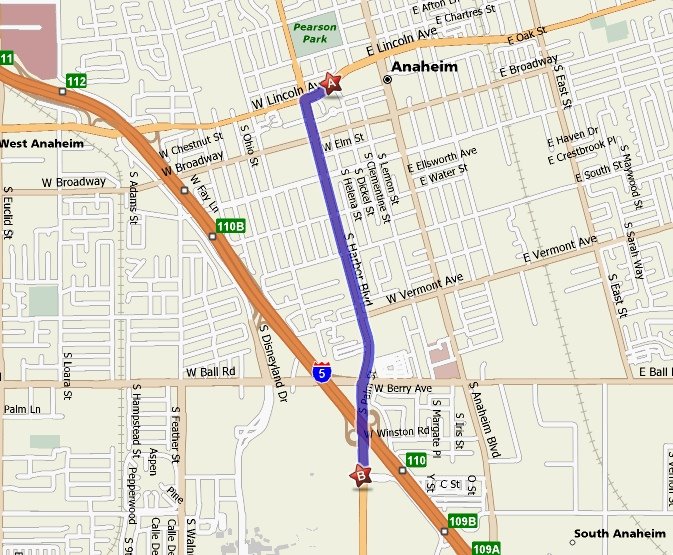 Well, “close by” is a relative term. It’s 1.68 miles away, according to MapQuest (right), and downtown and Disneyland are separated by a residential neighborhood.
Well, “close by” is a relative term. It’s 1.68 miles away, according to MapQuest (right), and downtown and Disneyland are separated by a residential neighborhood.
Then again, Disney sold the hockey team in 2005, and the team’s name changed from the Mighty Ducks of Anaheim to the Anaheim Ducks. Thus Disney has no reason to be fully committed to hockey.
How long before Forest City Ratner and parent Forest City Enterprises, who have no past history with professional sports, sell the Nets basketball team? According to the 10-K report (p. 9) filed in March with the Securities and Exchange Commission, one of the risks investors should recognize is this:
We Have Limited Experience Participating in the Operation and Management of a Professional Basketball Team, and Future Losses Are Expected for the Nets.
Gehry’s fuzzy geography
In a 7/1/08 Guardian of London interview headlined Let's twist again, Gehry recalled his upbringing in Toronto:
The Gehrys were "pretty poor. At school, I got beat up by Catholic Polish kids, miners' sons, who called me 'kike' and 'Christ killer'. But the French Catholics, the underdogs in Toronto, were on my side and I learned to fight back. I even got good at ice hockey. One of my favourite projects has been 'Disney ice', a rink we did in Anaheim in the mid 90s close by Disneyland."
 Well, “close by” is a relative term. It’s 1.68 miles away, according to MapQuest (right), and downtown and Disneyland are separated by a residential neighborhood.
Well, “close by” is a relative term. It’s 1.68 miles away, according to MapQuest (right), and downtown and Disneyland are separated by a residential neighborhood. Given Anaheim weather and traffic, it’s really not walkable--though there is a regular bus.
It makes you wonder how much feel the Los Angeles-based Gehry has for Brooklyn.
It makes you wonder how much feel the Los Angeles-based Gehry has for Brooklyn.
Comments
Post a Comment